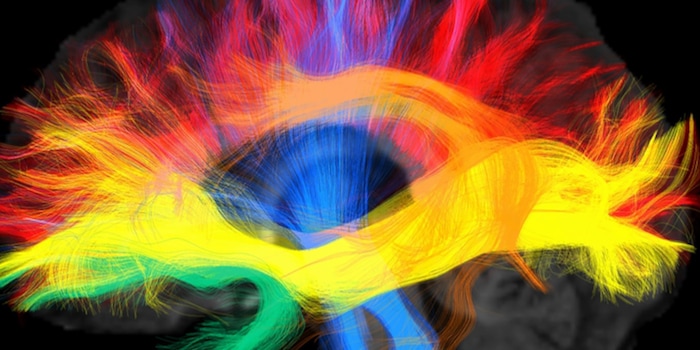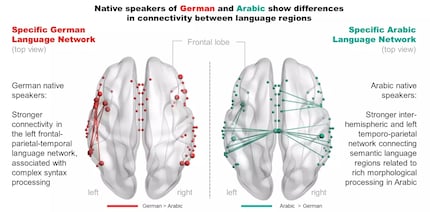
Typical "German" wiring
German and Arabic both have their pitfalls, but in different ways. This can also be seen in the brain: the language networks adapt to the special characteristics of the native language.
Languages can be difficult in different ways: Arabic, for example, is difficult to read because some sounds are not written. And German sentence structure is so complicated that it is easy to lose track. Both are reflected in brain anatomy, reports a research group from the Max Planck Institute (MPI) for Human Cognitive and Brain Sciences in Leipzig in the scientific journal "NeuroImage". According to the study, the special requirements of the native language contribute to the fact that certain language centres exchange information particularly strongly and create correspondingly broad communication channels.
The team led by brain researcher Alfred Anwander and his doctoral student Xuehu Wei took brain scans of almost 50 healthy adults with German or Arabic as their native language. The researchers used a magnetic resonance imaging technique called diffusion tensor imaging, which measures how water molecules move in brain tissue. This makes the white matter visible - the bundles of nerve fibres with which the neurons (the grey matter) of the cerebral cortex interconnect over long distances.
The researchers found stronger connections in the language network of the left hemisphere, where language is centred, in test subjects with German as their mother tongue. The fact that German needs particularly wide cables there could have something to do with its complex sentence structure: The position of many words in the sentence is comparatively free, and even words that belong together can be far apart. The left Broca's area - the grammatical centre - is very "sensitive" to complex German sentence structures, and the lower left frontal lobe furrow provides the memory capacity needed to mentally connect distant dependent sentence elements.
Arabic, in turn, harbours other challenges. Unlike in German, Arabic script does not represent each sound with its own character; the short vowels are often missing. When reading, the pronunciation and meaning of a word must then be deduced from context and previous knowledge, and the right hemisphere of the brain is increasingly involved for this purpose. And this leaves traces, for example in the corpus callosum, the main bridge between the hemispheres: "Native Arabic speakers showed stronger connectivity between the left and right hemispheres of the brain than native German speakers," reports Alfred Anwander in a press release from the MPI. He and his team also found stronger connections between semantic language regions in the temporal and parietal lobes. This could be "related to the relatively complex semantic and phonological processing in Arabic".

Source: © MPI CBS (Ausschnitt)
There have already been initial studies that have found typical neuroanatomical features for different languages. However, these were smaller samples and other languages such as Chinese and English. It is also known that grey and white matter change when learning a foreign language. The present study documents differences between two larger samples of native speakers. Next, the research group wants to investigate what happens in the brains of Arabic-speaking adults when they learn German for six months.
Spectrum of science
We are partners of Spektrum der Wissenschaft and want to make well-founded information more accessible to you. Follow Spektrum der Wissenschaft if you like the articles.
[[small:]]
Cover photo:© MPI CBS (detail) Diffusion tensor imaging, a form of magnetic resonance imaging, visualises the wiring of brain areas. The resulting image is created from computer calculations. (symbolic image)Experts from science and research report on the latest findings in their fields – competent, authentic and comprehensible.